"barre", the old English spelling vs. bar which refers to a measure of music, is used to indicate a placing of a finger across two or more strings. If covering all the strings it's called a full barre and if fewer than all the strings it’s a partial barre. It’s a classical guitar technic used for guitar, ukulele, mandolin and other fretted string instruments regardless of style.
barre, the old English spelling vs. bar which refers to a measure of music, is used to indicate a placing of a finger across two or more strings. If covering all the strings it's called a full barre and if fewer than all the strings it’s a partial barre.

This Video is NOT part of your LearningUkulele.com Site Access level. Sign-up for Premium Site Access or Upgrade your current access level to view this video. Sorry can't continue to justify giving so much away for FREE. For FREE videos hit up YouTube.
Available for Premium Site Access Plans Only
In classical guitar notation, there are music symbols for indicating both a full barre, the letter C with option Roman numerals CVII for the fret position and a partial barre using a ¢VII with a line through it like a cent sign. Pretty rare for anything other classical guitar music.
Typically reserved for the index finger, any finger can be barred across two or more strings when needed for some chord voicings. When using a barre in single-note melodic passages, solos, melodies it should be reserved for the index finger only as this allows you the use of your other fingers and not comprise your hand position. The exception would be for musical reasons, such as fast rhythmic double stop passages or the end of a phrase where you have time to recover.
A barre, allows you to transpose any open position chord to other keys/chords along the fingerboard by re-fingering the open position chord to allow finger one, the index finger free to play the open strings when transposed along the fingerboard.
Just What is a Barre
Chord?
Barre, the old English spelling vs. bar which refers to a measure of music, is used to indicate a placing of a finger across two or more strings. If covering all four strings it's called a *full barre*, if fewer than four strings it’s a *partial barre*. This is a classical guitar technique used for guitar, ukulele, mandolin, and other fretted string instruments regardless of style. In classical guitar notation there are actual music symbols for indicating both a full barre, the letter C with option Roman numerals CVII for the fret position and a partial barre using a ¢VII with a line through it like a cent sign. Pretty rare for anything other than traditional classical guitar music notation.
Typically reserved for the index finger, any finger can be barred
across two or more strings when needed for chord voicings. When a barre, used in single note melodic passages/solos it should be reserved for the index finger only as this allows you to still use the other fingers and not comprise your hand position. The exception would be for musical reasons such as fast rhythmic double stop passages or the end of phrases where you have time to recover.
A barre allows you to transpose any open position chord to other keys along the fingerboard by re-fingering the open position chord to allow finger one, the index finger, to be free. This allows transposition along the fingerboard to other keys. It is essentially a movable capo.
A, Bb Movable Form
A Major or just play A, the Canadian chord ( eh! )
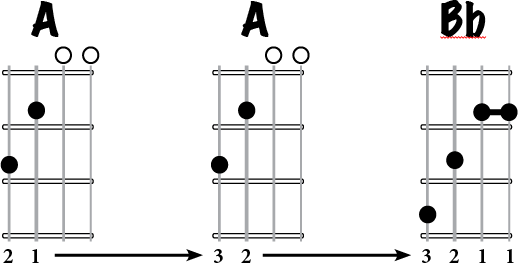
Using the open position, A major chord as an example 2100. Re-finger the chord using fingers three and two. The actual chord hasn’t changed, but finger one is now available to play the two open strings when transposed to other frets (keys).
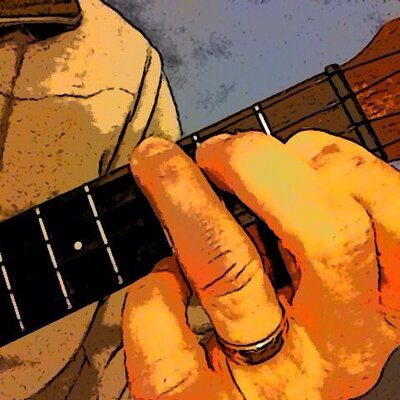 To play Bb major, move each note one fret higher and barre strings one and two at fret one for 3211. There is no need to barre strings three and four as these strings, handled by fingers three and two on strings three and four and would be redundant, would be redundant. As you can actually see in the text representation of the Bb chord 3211, the 11 is only needed on strings one and two. Although there isn’t as much tension on a ukulele as a guitar. There is no need to do more work than required. This allows for a more efficient and a lower maintenance technique.
To play Bb major, move each note one fret higher and barre strings one and two at fret one for 3211. There is no need to barre strings three and four as these strings, handled by fingers three and two on strings three and four and would be redundant, would be redundant. As you can actually see in the text representation of the Bb chord 3211, the 11 is only needed on strings one and two. Although there isn’t as much tension on a ukulele as a guitar. There is no need to do more work than required. This allows for a more efficient and a lower maintenance technique.
A few more of the A, Bb Movable Form chords.
Am
Am - pronounced A Minor - is one of the few open position chords that only require a single finger to play.
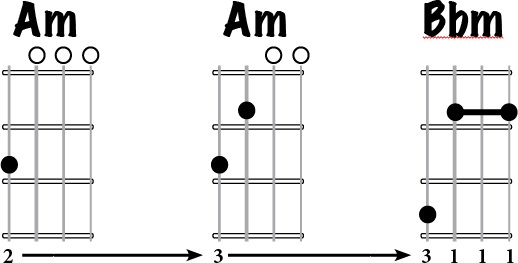
A little history about Am or A minor. It was discovered deep in the Kanawha & Hocking Coal and Coke Co. coal mine in Carbondale , West Virginia, USA by, wait for it…
Am.
A7
A7 — pronounced A Seven — like Am is one of the few open position chords that only require a single finger to play.
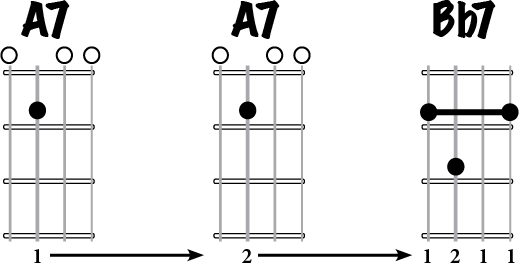
Am7
Am7— pronounced A Minor Seven — is all open strings and then transposed to an additional key along the fingerboard requires a full barre of finger one.
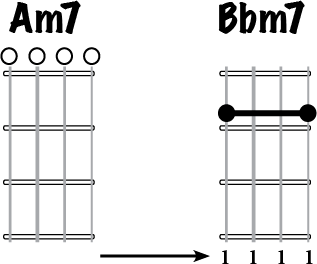
Only a few of the open position chords, when transposed up the neck actually need a full barre across all four strings A7 0100 and C7 0001 are two that when transposed to Bb7 1211 and C#7 1112 need a full barre across all four strings. You can actually see it in the text notation that is common for notating chords in email and on-line.
Barre Chords are actually that simple.
Here are a few tips for playing the barre
chords on a ukulele or any fretted string instrument.
- Don’t barre more strings that you need to. Although it’s pretty easy to press the strings down on a ukulele, there is no need to do more than you have to.
- Get a ukulele with a radius fingerboard. It really helps with playing chords in general. Pono ukuleles from Ko’olau Guitar and Ukulele are the only mass-produced ukuleles that I know of that have a radius fingerboard on a large percentage of their instruments - including all of their Pro Classic series. It is well worth it. The one other option is a custom instrument built to your specifications.
- For a barre with using the index finger, roll the finger slightly towards the nut, staying close to the fret. The side is the index finger is lot straighter than the palm side.
Related Lessons, Videos, Lesson Series, Songs, Books & Reference Charts, Resources & Assets, Workshops are below.
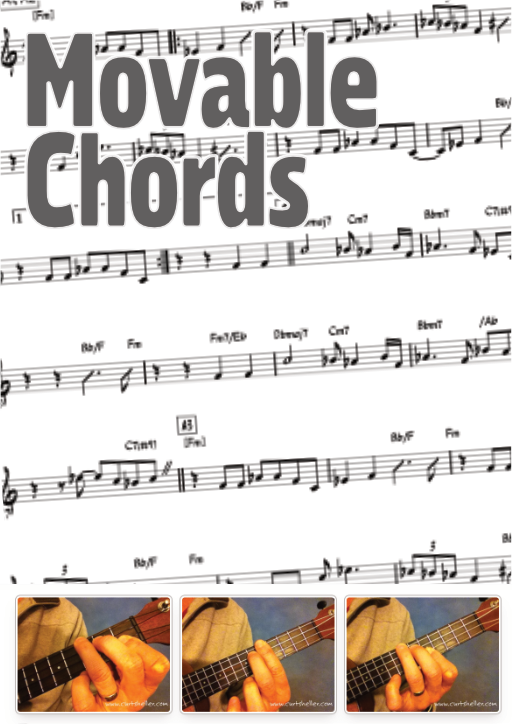
A series of weekly ukulele lessons originally presented throughout 2007 on movable ukulele chords as the "Ukulele Chord of The Week Series". Based on the Ukulele Chords book by Curt Sheller (me). It takes the open position chords and shows the movable form and the variations.

Covering basic ukulele chords that ALL uke players MUST know, movable chord forms, rock uke chords, how to transpose chords, learning the ukulele fingerboard and an introduction to 4-part jazz chords and more... FOR LEFTIES - Tunings: C, G, or D Tunings. Low or high string four variations.
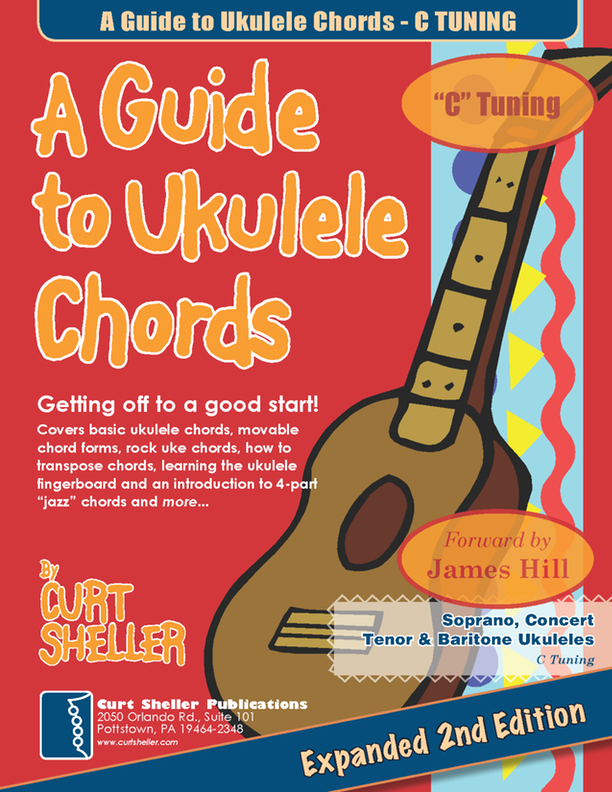
A Guide to Ukulele Chords, Second Edition is designed as a guide to ukulele chords. Covering the basic ukulele chords that ALL ukulele players SHOULD know. A Guide to Ukulele Chords covers movable chord forms, rock chords, how to transpose chords, learning the ukulele fingerboard and includes an introduction to 4-part, a.k.a jazz chords and more...


return in your investment)—it is this— learning the
f*ckingnotes of your OWN instrument. Sorry for the tough talks—but it is sooooo true!


Learn to read single note melodies in the first/open position is a lot easier than you might think. Book: Ukulele – Reading Music Series – Primer

An organized collection of daily practice and reference material for the contemporary ukulele player for developing the vocabulary and knowledge necessary for single note playing. Book: Daily Practice Material for the Contemporary Ukulele
Checkout the Books & Reference Charts for additional Handy, Dandy Reference Charts.

Ukulele Fingerboard Chart for C Tuning, Low or High G – G C E A

Ukulele Fingerboard Chart for G Tuning, Low or High A – D G B E

A handy reference chart of all 15 major and relative minor key signatures. US Letter 8.5 x 11 sized (ANSI-A) , A4



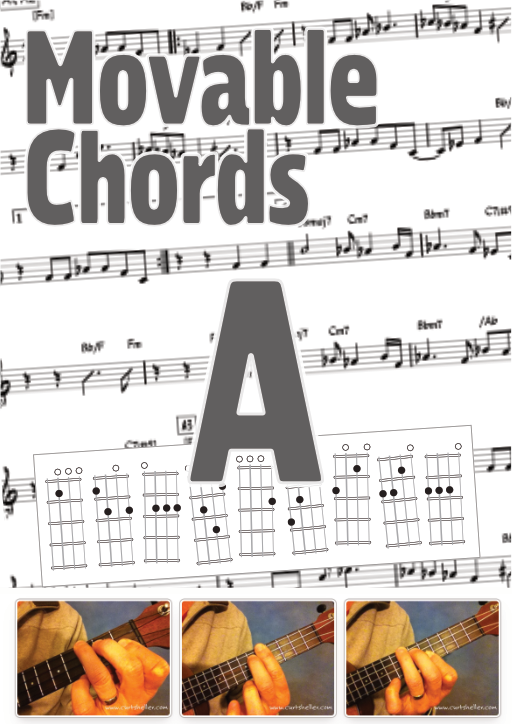
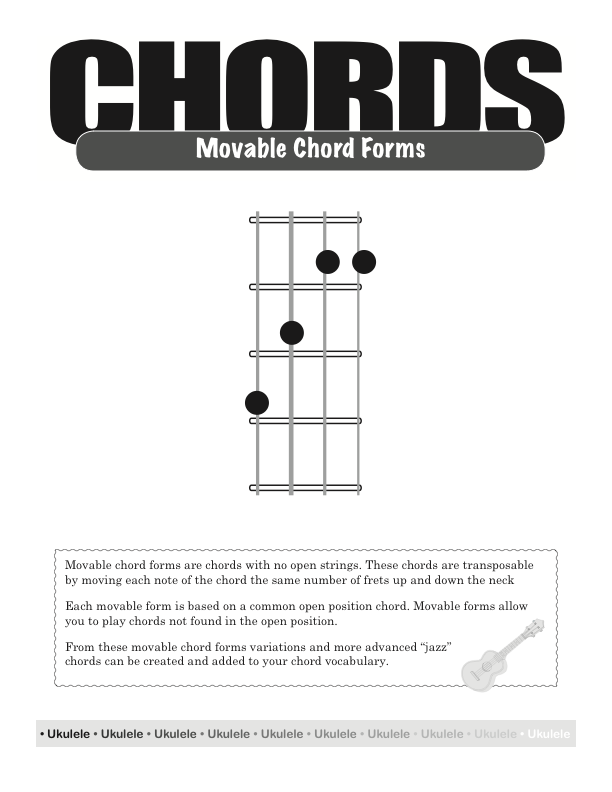






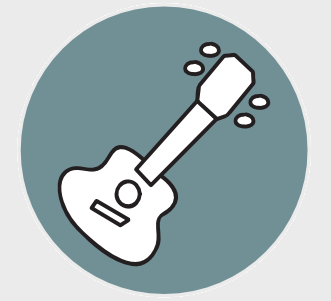
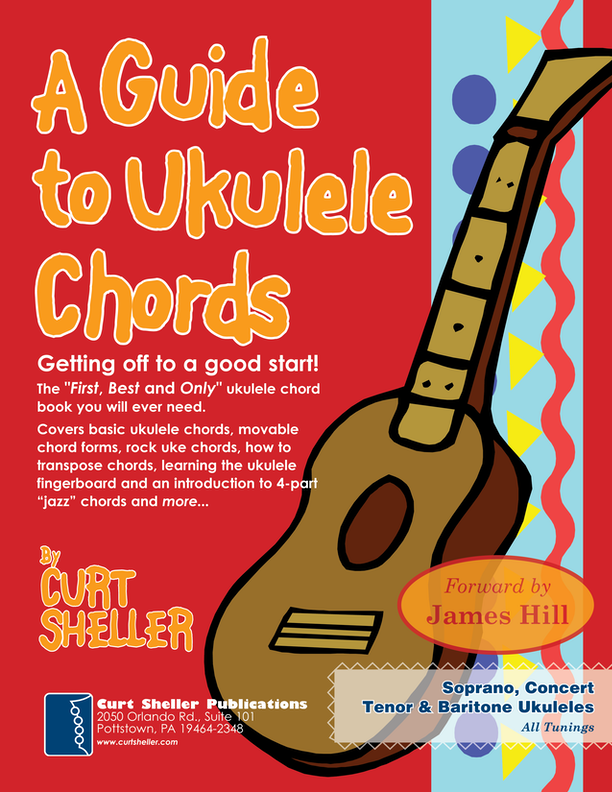

.jpg)